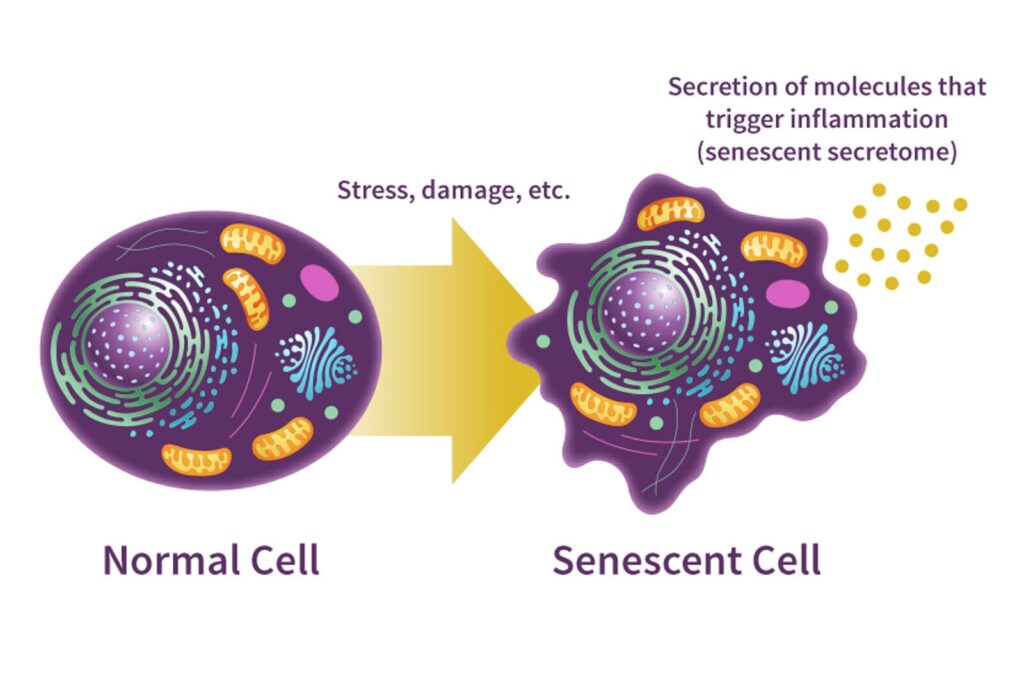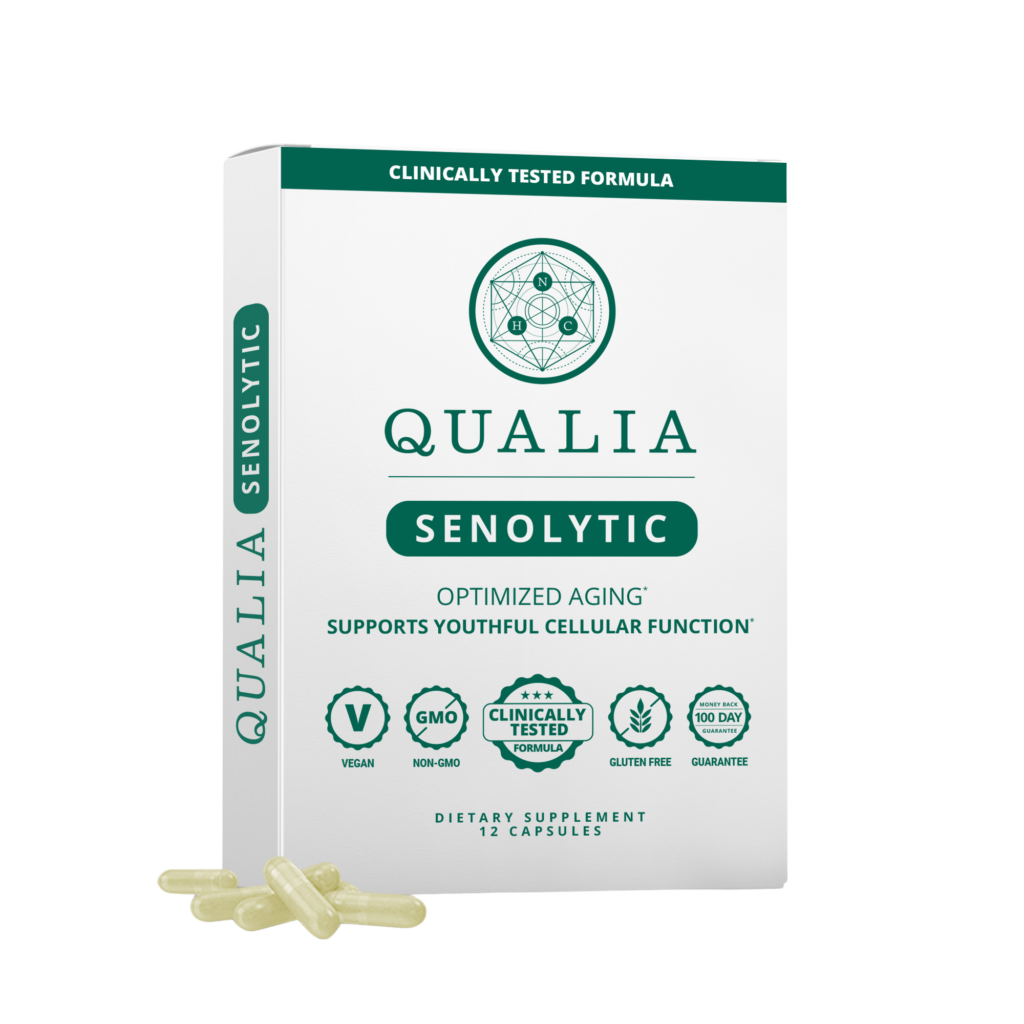August 19, 2025
Every passing day, billions of your cells quietly expire, making way for new replacements.
However, as you age, your regenerative capacity becomes less efficient. Some cells, damaged by oxidative stress, toxins, or genetic instability, cease dividing and enter a state of senescence—a kind of limbo in which the cell no longer contributes to healthy tissue function, yet also fails to be properly cleared by the immune system.
These lingering, dysfunctional cells are referred to as senescent cells, or “zombie cells”—donning this name because they remain metabolically active, but no longer serve a meaningful role in your body’s biological processes.
While cellular senescence does have an important, short-term role in wound healing and protection against cancerous growths, chronic accumulation of these cells is now understood to be a fundamental hallmark of aging.
Left unchecked, senescent cells begin to secrete a cocktail of pro-inflammatory compounds, known as the SASP (senescence-associated secretory phenotype), which can damage surrounding tissue, suppress immune function, impair mitochondrial activity, and accelerate age-related decline in everything from skin elasticity and joint mobility to energy levels, cognition, and recovery capacity.
Enter senolytics—a class of compounds that can selectively target senescent cells and help facilitate their removal from the body.
By reducing the burden of zombie cells and restoring a more youthful cellular environment, senolytics represent a promising and rapidly evolving frontier in the science of longevity, metabolic health, and systemic rejuvenation.
-
Senescent cells drive aging through chronic inflammation: Senescent or “zombie” cells accumulate with age and secrete SASP (senescence-associated secretory phenotype), a harmful mix of pro-inflammatory molecules that damage tissue, impair mitochondrial function, suppress immune responses, and accelerate biological aging.
-
Senolytics can selectively eliminate dysfunctional cells to promote rejuvenation: These compounds induce apoptosis specifically in senescent cells and are most effective when given in intermittent, high-dose pulses that overcome the cells’ resistance mechanisms, as shown in recent animal and early human studies.
-
Diet alone cannot deliver effective senolytic doses: Natural senolytics like fisetin and quercetin are present in common foods such as strawberries and persimmons (for fisetin) and onions and apples (for quercetin), but at concentrations too low to be clinically impactful, and poor bioavailability further limits their effectiveness without enhanced formulations.
-
Synergistic multi-compound formulations are essential: Clearing stubborn senescent cells requires targeting multiple survival pathways simultaneously; single-ingredient supplements rarely achieve meaningful senolytic effects, making combinational approaches crucial.
-
Qualia senolytic offers a targeted, research-backed solution: Combining nine highly bioavailable, plant-based compounds—including clinically dosed fisetin, enhanced quercetin (Quercefit®), and Senactiv®—this two-day-per-month supplement reflects the latest science to effectively reduce senescent cell burden and support healthy aging.
The Rise of Senolytics: A Breakthrough in the Science of Aging
In 2015, landmark studies from researchers at the Mayo Clinic and Scripps Research Institute identified the first naturally derived compounds capable of exerting senolytic effects in vivo.
Scientists found that senescent cells rely heavily on molecules like BCL-xL, a protein that blocks cell death signals; PI3Kδ, part of a survival pathway that promotes stress resistance and inflammation control; and p21, a cell cycle inhibitor that not only halts cell division but also helps stabilize the senescent state.
As such, the term “senolytics” (from senex, Latin for “old,” and lytic, meaning “to destroy”) was introduced by researchers to describe the studied molecules that were capable of inducing senescent cell death while avoiding healthy, proliferative cells.
These findings opened a new frontier in the longevity landscape, prompting a wave of investigations into botanical extracts and flavonoids with senolytic potential.
However, later research showed that these cells are tough to get rid of. If the treatment is too weak, inconsistent, or not carefully targeted, it often doesn’t work—senescent cells are stubborn and need a strong, well-designed approach to be effectively cleared.
You might be wondering, “What does this mean for me?”
Essentially, if you're over 30, senescent cell accumulation becomes a stubborn enemy, requiring a targeted, multipronged plan that involves much more than an occasional low dose of one or two senolytics.
But don't worry, I'm about to tell you *exactly* what you need to do to start effectively ridding your body of senescent cells.
Why Diet Alone Rarely Clears Your Body of Senescent Cells
Many of the senolytic compounds discovered to date are present in common foods, but typically at subtherapeutic concentrations.
Consider fisetin—a powerful flavonoid found in strawberries and persimmons. Research shows it can help clear out those stubborn senescent cells by nudging them toward self-destruction. It does this by activating p53 signaling—your body’s natural “damage control” switch—balancing key survival proteins like BCL-2, and supporting healthy cellular cleanup processes.
In other words, fisetin helps your body’s built-in system sweep out aging cells, keeping you younger and healthier from the inside out.
Despite its potential, the average dietary intake of fisetin is FAR below the doses used in clinical or preclinical studies. A full pint of strawberries, for example, contains roughly 57 mg of fisetin.
This is a problem because efficacious senolytic doses reported in animal studies translate to several hundred milligrams per human equivalent dose. Additionally, efficacy occurred when high-dose senolytics were consumed intermittently rather than continuously.
The same applies to quercetin, another well-characterized senolytic flavonoid mentioned above. While abundant in foods like onions and apples, quercetin suffers from notoriously poor bioavailability.
However, advanced formulations such as Quercefit®—a phytosome-enhanced version—demonstrate up to 20-fold improved absorption and are more suitable for targeted interventions.
Other promising compounds include luteolin, piperlongumine (a natural amide from Piper longum), and Senactiv® (a proprietary combination of Panax notoginseng and Rosa roxburghii), each with distinct mechanisms of action relevant to senescent cell clearance.
How Diverse Compounds Target Aging From All Angles
What’s especially interesting is that many of these compounds work through different, complementary pathways. Some boost your cells' ability to handle oxidative stress (like supporting OXR1, a key defense gene), others dial down inflammatory cytokines, and some enhance mitochondrial function.
Together, they can create a multi-pronged anti-aging effect that helps your body stay resilient, energized, and biologically younger.
The major problem with all of these compounds is the impracticality of consuming them via foods alone in adequate dosages (let alone with important ratio and frequency considerations also maintained). Additionally, many of these bioactives are virtually absent from the modern food supply entirely.
In simple language, even if you rarely take supplements, these compounds are particularly valuable in combating senescent cell accumulation because food alone will fall short.
But the devil is in the details of how to supplement for senescent cell elimination, which I'll cover next…
Common Pitfalls in Senolytic Supplementation
As discussed above, senescent cells are clever survivors that use multiple defenses, so addressing just one pathway or relying on low doses won’t cut it.
To truly unlock the power of senolytics, it’s crucial to understand the science behind dosing strategies, ingredient synergy, bioavailability, and product quality. Avoiding the common pitfalls listed below can help you clear out stubborn zombie cells and support your long-term vitality.
1. Ignoring Synergy
Senescent cells rely on multiple survival pathways, meaning that single ingredient interventions are unlikely to produce meaningful effects.
Effective senolytic strategies require combining compounds that work together to hit enough targets simultaneously, reaching a critical “threshold” that triggers cell death.
Simply put, a multi-pronged approach is essential to overcome these cells’ built-in defenses.
2. Subtherapeutic Dosing
The misconception that low-dose, daily exposure to senolytic ingredients can mirror the outcomes of periodic high-intensity dosing ignores some important scientific realities.
Intermittent, high-concentration “pulses” of senolytics better reflect the protocols used in preclinical and emerging human trials. Much like pruning a plant monthly (rather than daily), periodic dosing can be more effective.
3. Lack of Clinical Validation
As with any emerging category in nutraceutical science, the risk of under-validated, marketing-driven products is high.
Robust formulations require clinical research—not only on individual ingredients but, ideally, on the complete formula. Transparent third-party testing and rigorous quality control are non-negotiable.
4. Neglecting Bioavailability
Without considering absorption, even promising compounds may prove ineffective…
For example, quercetin is a powerfully proven senolytic, but its bioavailability can be shaky.
Quercefit® (more on this in the next section) provides a standardized form of quercetin 20 times as bioavailable, and standardized extracts of olive leaf with reliable oleuropein content, the special sauce of its relevance as a senolytic, are essential for achieving the sophisticated potency needed to slay zombie cells in meaningful amounts.
Targeting Senescent Cells with a Multi-Pathway, Research-Backed Formula
One of the only (or perhaps, *the* only) formulation designed with these scientific principles in mind is Qualia Senolytic.
Developed through extensive research and leveraging input from experts in molecular biology and aging, it combines nine highly bioavailable, plant-derived compounds—each selected for its unique role in targeting senescent cells.
The formula includes:
- Fisetin (at clinically relevant doses): A potent flavonoid found in fruits like strawberries, fisetin promotes senescent cell apoptosis by modulating p53 signaling and balancing anti-apoptotic proteins, helping to clear damaged cells.
- Quercefit® (enhanced quercetin): This highly bioavailable form of quercetin supports senolytic activity by inhibiting survival pathways in senescent cells and reducing inflammation, making it easier for the body to eliminate these cells.
- Piperlongumine: Derived from the long pepper plant, piperlongumine selectively induces oxidative stress in senescent cells, pushing them toward self-destruction without harming healthy cells.
- Luteolin: A flavonoid with strong anti-inflammatory and antioxidant properties, luteolin disrupts key pro-survival signaling in senescent cells and supports mitochondrial health.
- Senactiv®: A proprietary blend that stimulates cellular energy production and promotes healthy cell function, Senactiv® helps rejuvenate tissues and supports the removal of senescent cells.
- Olive leaf extract standardized to oleuropein: Oleuropein is a powerful antioxidant that modulates inflammatory pathways and enhances cellular cleanup processes, contributing to senolytic effects.
- Additional adaptogens and supportive cofactors with emerging senolytic evidence: These compounds provide metabolic and immune support, improving the body’s ability to target and clear senescent cells effectively.
Notably, Qualia Senolytic is designed for use just two days per month—a protocol informed by the aforementioned realities of hitting senescent cells with occasional-but-potent doses of diverse and complementary senolytic ingredients.
Summary
While foundational lifestyle practices like resistance training, interval workouts, and intermittent fasting remain essential tools for slowing cellular aging, senolytics offer a targeted new layer of support.
By helping to clear out senescent “zombie” cells—those dysfunctional, inflammation-promoting cells that accumulate with age—senolytic compounds can make room for healthier cellular regeneration and improved tissue function. But because these cells are deeply resistant to elimination, effective supplementation requires a strategic, multi-compound approach. Formulas like Qualia Senolytic, designed around clinical research and intelligent dosing, represent a cutting-edge advancement in the quest to optimize aging, recovery, and long-term vitality.
Want deeper insights into senescent cells—and how Qualia Senolytic can help clear them from your body to support healthier aging, better energy, improved recovery, and enhanced cellular function?
If you’re over 30—or just want to get ahead of the game—you can check out the podcast episode below to discover more insights into how clearing out “zombie cells” can be a powerful tool for healthy aging:

